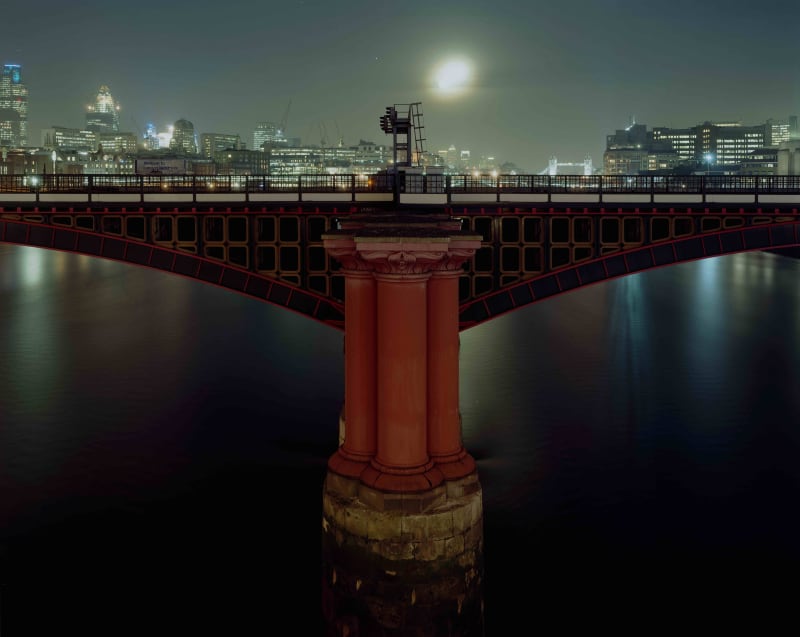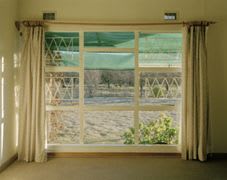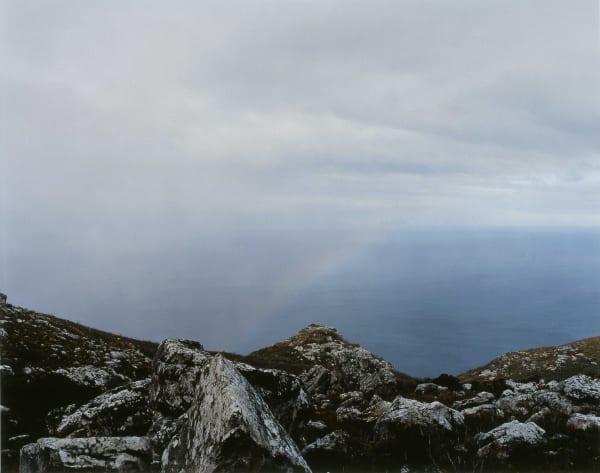John Riddy: Recent Places
Recent Places is the first of two consecutive exhibitions of new works by John Riddy.
It encapsulates the themes and concerns that are key to Riddy’s practice; the relationship between photography and place, architectural symmetry, spatial illusion and the world as a sculptural object. The crucial difference with the works in this exhibition is that they are made exclusively in colour. By introducing this element Riddy subtly emphasises the particular characteristics of the locations he has chosen to photograph with the groupings in each separate gallery space allowing one to encounter distinct and very different qualities of colour and light.
The exhibition opens with the grand colonial architecture of Maputo’s Central Railway Station. The classical recession and feeling of depth in the first two images contrasts sharply with the photograph of one of the city’s elegant but mouldering modernist apartment blocks here seen bathed in rich tropical light and encroached upon by equatorial vegetation. In this work the emphasis is on flat planes and shallow space seemingly held behind a web of trees.
The next series of images depict night-time scenes in the City of London where artificial illumination creates saturated colour and heightens the sense contemporaneity, here even the moon appears as a neon streak. At the same time the photos relate strongly to 19th Century photographers’ preoccupations with scenes of industrial advance. Pictures of classic, Victorian, massively engineered structures, such as Blackfriar’s railway bridge spanning the river, are shown along side images of The City’s burgeoning high-rise architecture. In Riddy’s version London appears almost weightless, distanced but somehow not unfamiliar, it is a place of where incongruity produces instances of surprising beauty and enjoyment.
The landscapes of South Africa are the subject of the works on show in the basement galleries. These desolate places have an almost mythical air often evoking biblical landscapes from early renaissance painting. A view across the sea from The Cape feels as if it has never been witnessed by humans with its hazy horizon and rainbows dissolving into mist and light. The pictures of the small Afrikaans settlements and their iconic religious architecture both compliment and throw into stark contrast the surrounding primal landscapes.
The two final works in the exhibition are concerned with spatial structure – the composition of the images seems to hold the viewer at bay at the same time there is a very tangible sense of the parallel time zones – of the world within the frame of the photograph and that of the present.
John Riddy would like to thank Jean Lippett and everyone at Visions for their help in the realisation of this exhibition.
-
 JOHN RIDDYLondon (Blackfriars), 2003C-type print46 x 60 cm
JOHN RIDDYLondon (Blackfriars), 2003C-type print46 x 60 cm
18.1 x 23.6 inEdition of 5 -
 JOHN RIDDYCederberg, 2001C-type print46 x 60 cm
JOHN RIDDYCederberg, 2001C-type print46 x 60 cm
18.1 x 23.6 inEd. 1 of 5 + 1 AP -
 JOHN RIDDYEcho Valley, 2003C-type print46 x 60 cm
JOHN RIDDYEcho Valley, 2003C-type print46 x 60 cm
18.1 x 23.6 inEd. 1 of 5 + 1 AP -
 JOHN RIDDYPrince Albert, 2003C-type print46 x 60 cm
JOHN RIDDYPrince Albert, 2003C-type print46 x 60 cm
18.1 x 23.6 inEd. 1 of 5 + 1 AP





